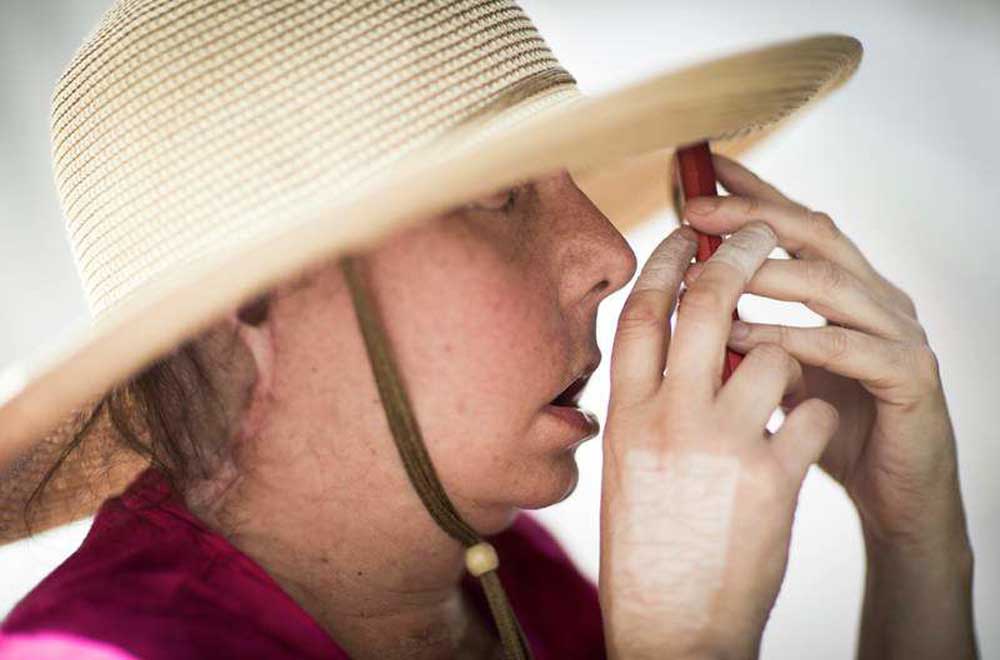A new face, and a new beginning
Published 5:00 am Saturday, October 26, 2013

- Carmen Tarleton, who received a face transplant after being beaten and burned beyond recognition, brings her cellphone close to read a text message at the Pemi Valley Bluegrass Festival in Thornton, N.H. Face transplants are still an experimental procedure, but eight months after the operation, there is evidence that Tarleton's new face is becoming part of who she is.
THETFORD, Vt. — At 1:30 a.m. on Valentine’s Day this year, Carmen Tarleton left her rural home here and drove through the frigid dark to Brigham and Women’s Hospital in Boston. Her doctor had called hours earlier with the news she had been waiting for: A suitable donor had been found. She would get a new face.
Almost six years had passed since her estranged husband had broken into her house one spring night, beat her with a baseball bat and soaked her with industrial lye. The attack nearly blinded Tarleton, and burned her beyond recognition.
She lost her eyelids, upper lip and left ear. What remained of her face and much of her body was a knobby patchwork of scar tissue and skin grafts, painful to look at and far more painful to live with.
Now, after overcoming some initial fears, she was ready to receive someone else’s features. After 15 hours of transplant surgery, Tarleton, 45, emerged from the operating room with what looked to her mother, Joan VanNorden, like a puffy, surreal mask. At first she wanted to faint as she stared at the new face, smooth and freckled, stitched to her daughter’s pale scalp. But when Tarleton started talking in her old familiar voice — “Can’t you just get in here?” — VanNorden relaxed.
“I said, ‘This is who Carmen is now,’ and it really looked beautiful,” she recalled. “Although it didn’t look anything like her, it was her face.”
Face transplants are still an experimental procedure, the first having taken place eight years ago in France. Some two dozen full or partial transplants have been completed worldwide, including five at Brigham and Women’s, which used nearly $4 million in research grants from the Department of Defense to do four of the surgeries. Arteries, veins, nerves and muscles from the donor face must be connected to the recipient’s, in what Dr. Bohdan Pomahac, Tarleton’s chief transplant surgeon, called “by far the most complicated operation that I do.”
Yet the psychological impact of a face transplant is perhaps as far-reaching as the surgical one. Unlike a kidney or liver or heart, a donated face is visible to all, challenging recipients and their loved ones to incorporate an entirely new countenance into long-held perceptions of a person’s identity.
Tarleton’s appearance is still evolving: Her scalp was so badly burned that hair will never return to parts of her head, but her donor’s hair, the same shade of brown as her own, is growing around her forehead and temples. Her right eye remains closed, and her left droops. Her face is sometimes masklike, betraying little emotion, because the muscles are still reconnecting and she cannot yet move them well. And that mask, oddly enough, looks like neither her nor the woman who donated it.
But eight months after the operation, there is evidence that Tarleton’s new face is more than just donated tissue and is becoming part of who she is.
When her family thinks, or even dreams, about her, they imagine her new visage.
“When someone at work asks me, ‘How’s Carmen?’ the picture that comes up in my mind more and more is that face,” said Tarleton’s sister, Kesstan Blandin.
Yet for Tarleton herself the process of acceptance has been trickier. For one thing, her poor vision keeps her from seeing herself clearly unless she holds a mirror up close.
“I don’t yet feel it is ‘my face,’” she wrote in a recent blog post. “I feel like I am still borrowing it.”
Tarleton’s former husband, Herbert Rodgers, 58, pleaded guilty to a charge of maiming and is serving a prison sentence of at least 30 years. Rodgers told the police that he had been angry at Tarleton, believing she was seeing another man after they separated.
Tarleton underwent a number of reconstructive surgeries but with little success. When Pomahac called in May 2011 to propose a face transplant, Tarleton’s mind first leapt to a “Twilight Zone” episode that had jarred her as a child, about a man who could change his appearance to look like other people.
“Initially I felt that it was very sci-fi,” she said in a recent interview.
But she and her family started researching, and after a few weeks of weighing the pros and cons — for one thing, she is likely to be on immunosuppressant drugs for the rest of her life, raising her risk of infection and cancer — Tarleton decided to forge ahead.
After a number of trips to Boston for physical and psychological screening to determine whether she was a good candidate, she got on the donor list that fall.
“It was like a big surprise, a big gift,” she said. “I’d already accepted my disfigurement, fine. But I accepted it believing there wasn’t an alternative.”
The things Tarleton wanted from a new face were more pragmatic than aesthetic. Tight bands of scars ringed her neck, causing debilitating pain. She drooled constantly and could not blink, jeopardizing a synthetic cornea in her left eye. And with her face frozen from scarring, it was hard for others to read her emotions.
For a time, she was devastated that she could not see “the old me,” as she put it. But she moved on, writing a book about her physical and emotional recovery from the attack and speaking publicly about the experience. She seemed mostly unconcerned about her appearance.
In December 2012, she gained a more urgent desire for a new face. She had started taking piano lessons at a music shop not far from her home. Her teacher was Sheldon Stein, an earthy, soft-spoken musician with whom she felt an instant affinity. The feeling, it turned out, was mutual. The two say they are in love.
“I kept looking in the mirror all of a sudden when I met Sheldon,” she said. “I wasn’t insecure before. But now — now you have feelings for somebody and now you have something to lose, when before, one of the reasons I did so well is I had nothing to lose anymore.”
Tarleton has undergone nearly 60 operations, mostly skin grafts, at Brigham and Women’s and has visited 21 times since her latest release in March. On this day she was exhausted, recovering from a bad headache the previous night and a recent fall that had left her with an aching foot. But she had a bit of good news for her doctors.
“If I put my head on Sheldon’s chest, I can feel his hair,” she said, “and I couldn’t before.”
Tarleton also met with Bridget Bowler, a speech therapist who is helping her learn to move her new lips — where nerve function typically takes the longest to return in transplant recipients — and practice facial expressions. She still has an air of the ventriloquist when she speaks, a habit that Bowler is trying to help her shake.
“One of these days in the near future,” Tarleton said, “when I start to cry or I laugh, you’re going to be able to tell by looking at me how I feel.”







